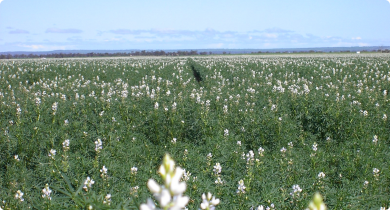Lupins
Western Australia is the world’s largest producer and exporter of lupins with the majority exported as animal feed to the European Union, Japan and Korea – delivering the state about $65 million in export earnings in 2011–12.
Lupins are now being promoted as human food with medical studies confirming their benefits in combating high blood sugar, heart disease and obesity.
Since the release of the first fully domesticated Australian sweet lupin in the late 1960s, lupin breeding by the Department of Primary Industries and Regional Development has resulted in a doubling of lupin yields from 0.7-1.5 tonnes per hectare.
The department supports the pre-breeding, breeding, agronomics and market development of the WA lupins industry, in conjunction with industry partners.
Articles
Filter by search
Filter by topic
- (-) Remove Pests, weeds & diseases filter Pests, weeds & diseases
- (-) Remove Grains research & development filter Grains research & development
- Pests (3) Apply Pests filter
- Wheat (3) Apply Wheat filter
- Diseases (3) Apply Diseases filter
- Pest insects (2) Apply Pest insects filter
- Pulses (2) Apply Pulses filter
- Viruses & virus-like (2) Apply Viruses & virus-like filter
- Oats (2) Apply Oats filter
- Weeds (2) Apply Weeds filter
- Crop weeds (2) Apply Crop weeds filter
- Canola (2) Apply Canola filter
- Barley (2) Apply Barley filter
- Crop diseases (2) Apply Crop diseases filter
- Pasture management (1) Apply Pasture management filter
- Nematodes (1) Apply Nematodes filter
- Pastures (1) Apply Pastures filter
- Soil nutrients (1) Apply Soil nutrients filter
- Soils (1) Apply Soils filter
- Mechanical, physical and cultural (1) Apply Mechanical, physical and cultural filter
- Soil acidity (1) Apply Soil acidity filter
- Fungi (1) Apply Fungi filter
- Chemicals (1) Apply Chemicals filter
- Bacteria (1) Apply Bacteria filter
- Climate, land & water (1) Apply Climate, land & water filter
- Control methods (1) Apply Control methods filter
- Fungicides (1) Apply Fungicides filter
- Managing soils (1) Apply Managing soils filter




